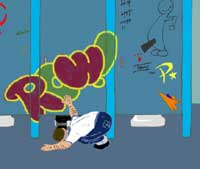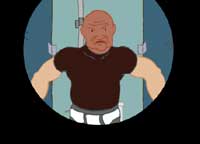The Top 10 Flash Cartoon Animation Clichés
May 17, 2004
In our last article, we looked at the types of Flash cartoon animation one can create. This article was necessary to expose the many opportunities that are available to animation directors and animators when undergoing a Flash animation project. It was also to inspire them to avoid typical clich®s that we are about to cover in this article.
Flash, whether it is used for Web site designs or cartoon animation and games have a bad name with most people. Many see it as an annoying addition that often does not improve Web surfing. However, Flash is but a technology. By creating better cartoons with this program, it will eventually increase the conversion rates of folks who visit and use sites with Flash contents.
10 -Vectorized Bitmaps
Even the folks at Toon Doctor have been guilty of this one. Using the Swap Bitmap command to transform bitmaps into vector drawings can be a smart use, but not always. Before converting bitmaps, ask check if using them with some compression might not be a better idea visually and concerning size. Converting to vector drawings does not always lead to bandwidth economy.
9- Limited Lip Sync
 Having a library of objects that one can reuse throughout an animated project are a time saver and effective use of assets. Many Flash cartooning sources encourage this. In lip sync, animators create several mouth shapes superimposed on the jaw of the characters. Making but the mouth change looks cheesy and cheap. When people speak, their jaws move too.
Having a library of objects that one can reuse throughout an animated project are a time saver and effective use of assets. Many Flash cartooning sources encourage this. In lip sync, animators create several mouth shapes superimposed on the jaw of the characters. Making but the mouth change looks cheesy and cheap. When people speak, their jaws move too.
The problem is that it's not enough to match the sounds with the mouth shapes. Few Flash lip sync sequences made with Flash avoid this, unlike television and film animation. When creating lip sync animation, create extra heads and extra jaw position that you may superimpose on top of a character's head or body. It will make your animation less static.
8- Animating Visual Properties
Often, animators add transparencies to smoke elements. Other times, when they want to portray a character's changing mood, they will make their head turn red or purple. Manipulating the visual properties of a movie clip saves bandwidth, but doesn't always work for animation because it looks mechanical and too smooth. In the real world colour transitions aren't so clean.
When people's faces turn red, they have patches of red in part of their faces, their nose and cheeks are always redder. It often looks like some ink is spreading over their face. Work on the timing aspects and add a random colour like green, before turning from pink to purple. Sure it looks out of place, but that's what cartoon animation is about.
7- Animating Bitmaps
This technique involves stretching part of images, like the mouth of characters to they can speak. The problem with this technique is that but one drawing is used to create several instances of motion. Never try to create animation with few elements. You can't add what doesn't exists in animation. Take several more pictures and play with them and their timing instead.
6- Bitmap With Bad Decals
Several Flash animators using bitmaps haven't discovered the use of PNG files with alpha channels. It always gives you a better result than trying to decal an illustration within Flash, using the Lasso and breaking apart bitmap files. Before importing your files from Photoshop, separate your elements there. There's no need to have to zigzagged crumbs around bitmaps.
5- Compressed Sounds
 Sounds can increase projects' size. However, there is a tendency by many Flash developers to condense the sound files as much as possible to make the file smaller. The sounds then sound like they are coming from a metal box. While reducing a Flash movie's size is always good, remember that diminishing sound quality negatively affects Flash cartoon animation.
Sounds can increase projects' size. However, there is a tendency by many Flash developers to condense the sound files as much as possible to make the file smaller. The sounds then sound like they are coming from a metal box. While reducing a Flash movie's size is always good, remember that diminishing sound quality negatively affects Flash cartoon animation.
4- Limited Animation
Limited animation has fostered much stand-up comedy Webisodes. While fun, Animation is not about static mouths that move and walk cycles with three drawings. Animation is about movement. Even when viewing stand-up comedy cartoons, viewers expect drawings to move. They often feel cheated without knowing why. Motion is critical.
3- Gradients
Using gradients to colour backgrounds or fake balls is a cool trick that's been abused by most Flash animators. Using gradients tells a lot about the pervasiveness of the tools available in Flash. Just because you can create a gradient effect, it doesn't mean that you have to. There might be other way with more interesting visual stimuli to achieve similar colouring effects.
2- Motion Tweening & Rotating Limbs to Fake Animation
Using motion tweens to rotate, scale and pan objects is simple but not a substitute for full-frame animation. Often, animators will rotate characters' arms at their sockets to fake movements and save on drawings. A static arm rotating at the shoulder of a character does not look like a moving arm. It looks like a rotating drawing used instead of an extra animated drawing.
1-The Flat Flash Look
The 1990s television cartoon looks influenced Flash animation. The prevalent look for Flash cartoon animation is a flattened palette with thick contour lines. That style is easy to reproduce in Flash. Although there is nothing wrong with the style artistically, animators have overused it. Flash is not limited to the flat cartoon look with bright colours. In fact, only one's imagination is a barrier.
Having looked at the top ten technical Flash cartoon animation clich®s, in our next article we'll direct our focus on the storytelling aspects involved in the creation of cartoon animation with Macromedia Flash. Focusing on the storytelling structure will help us eliminate the chances of relying on the standard clich®s above which we've explored.
Related Articles:
Coolstreak Cartoons Inc.
Copyright ® 2004. Use of material in this document®including reproduction, modification, distribution, electronic transmission or republication®without prior written permission is strictly prohibited.



